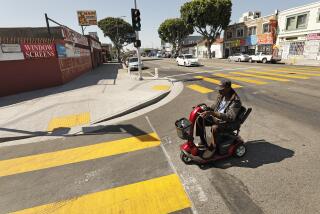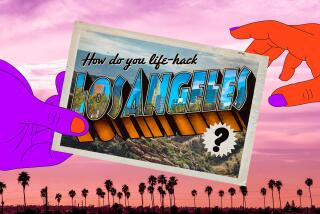Intersection of Rules and Etiquette
- Share via
Dear Street Smart:
When making a left turn, how far into the intersection should the first car go when there is a string of cars behind it? One of my pet peeves is watching the first car straddle a crosswalk, then make the turn just as the signal turns yellow, leaving me and two or three cars stranded.
When I’m the first car, I usually move up to the middle of the intersection, leaving the same space opening for the opposing traffic to turn left and, if there is enough space, aligning myself as closely as possible to the left lane I’m turning into. The cars behind me make the light also, with a blink of yellow at the end of the turn.
What is the proper, legal way to make this turn? In early morning hours, a person can wait through two or three sequences to turn left because of this problem.
Sheila Caldwell
Anaheim
The California Vehicle Code says that a car turning left against a green light can enter the intersection before making the turn as long as it yields to oncoming traffic. The code does not, however, specify just how far into the intersection the car should or shouldn’t go.
In practice, says Sandra Houston, a spokeswoman for the California Highway Patrol, you should never pull far enough into the intersection to interfere with the ability of a car going the opposite direction to turn left.
However, she said, the law doesn’t require you to go any particular distance either, and, generally, one should err on the side of caution.
“It’s one of those things that should be governed by common sense,” Houston said. “I don’t think it’s a real black-and-white situation--you want to be a courteous driver. A lot of people think, ‘OK, three of us should make it on the yellow light,’ but it’s not a rule.”
Dear Street Smart:
I have tried to help the Mrs. understand safe hand positions on the steering wheel. She insists on having both hands at the 4 o’clock or 7 o’clock position when turning left or right in an intersection or mountain road. Can you suggest information that would help her better understand the safe use of hand positions on the steering wheel?
Russ Kinney
Anaheim
The best place for your hands in most instances is in a balanced and comfortable position, says Rich Schweiger, who teaches driving to California Highway Patrol officers. Generally speaking, Schweiger says, “balanced and comfortable” means one hand in the 10 o’clock position with the other at 2 o’clock; or slight variations such as 9 o’clock/3 o’clock or 8 o’clock/4 o’clock.
“If you have both hands in the 4 o’clock or 7 o’clock position, when you go to turn left or right your arms are going to bind up, and you’re not going to be able to turn efficiently,” he says.
Dear Street Smart:
Is it legal for a vehicle (passenger auto type) to tow a trailer with a boat or motorcycle in the carpool lane on our freeway system? I know the vehicle has to have two or more persons in it--the question has to do with towing a separate trailer.
Ben von KleinSmid
Corona del Mar
A passenger car towing a trailer must not exceed 55 mph and therefore is restricted to the far-right lane.
“You can’t tow anything in the carpool lane,” said Houston, of the CHP.
Street Smart appears Mondays in The Times Orange County Edition. Readers are invited to submit comments and questions about traffic, commuting and what makes it difficult to get around in Orange County. Include simple sketches if helpful. Letters may be published in upcoming columns. Please write to David Haldane, c/o Street Smart, The Times Orange County Edition, P.O. Box 2008, Costa Mesa, CA 92626, send faxes to (714) 966-7711 or e-mail him at David.H[email protected]. Include your full name, address and day and evening phone numbers. Letters may be edited, and no anonymous letters will be accepted.
More to Read
Sign up for Essential California
The most important California stories and recommendations in your inbox every morning.
You may occasionally receive promotional content from the Los Angeles Times.










